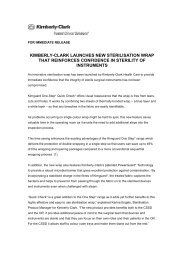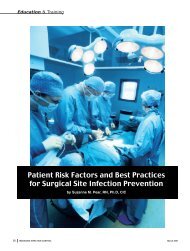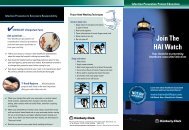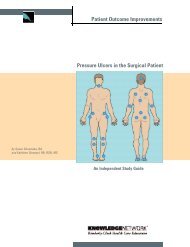Reducing Ventilator Associated Pneumonia (VAP) - HAI Watch
Reducing Ventilator Associated Pneumonia (VAP) - HAI Watch
Reducing Ventilator Associated Pneumonia (VAP) - HAI Watch
You also want an ePaper? Increase the reach of your titles
YUMPU automatically turns print PDFs into web optimized ePapers that Google loves.
<strong>Reducing</strong> <strong>Ventilator</strong><strong>Associated</strong> <strong>Pneumonia</strong>(<strong>VAP</strong>)14/10/10 Network Safety MeetingC Spencer, ICM Consultant,Lancs Teaching Hospitals
In this presentation…• Impact of <strong>VAP</strong>• Aetiology of <strong>VAP</strong>• Deliberately little about how to diagnose it• Technical <strong>VAP</strong> Prevention Interventions:Bundles – Is there evidence?How are they evolving?What are the key interventions?• Non-Technical <strong>VAP</strong> Prevention Interventions
Is <strong>VAP</strong> important?• Most common HCAI in Critical Care, 45% of allinfections on ICU (1)• Occurs in 9-27% of ventilated ICU patients (2,3,4)• Increases relative risk for mortality by 27-45% (absoluteincrease 5.8-10.4%) (5,6,7)• Increases ICU length of stay by 6.1 days (8)• Each case costs ~£7000 (based on US figures) (8)• Accounts for 2% of ICU bed days (9)1. Vincent et al 1995 2. Ibrahim et al 2001 3. Craven et al 1996 4. Rello et al 2002 5. Fagon et al 19936. Nguile-Makao et al 2010 7. Heyland et al 1999 8. Safdar et al 2005 9. Muscedere et al 2008
Why is there increasing focuson <strong>VAP</strong>?• We understand the pathogenesis better• Increasing body of evidence for prevention hasdeveloped since late 90’s• <strong>VAP</strong> is no longer viewed as inevitable complication ofinvasive ventilation• Care bundles are evolving as evidence grows• Pioneers employing bundles now quote remarkably low<strong>VAP</strong> rates• <strong>VAP</strong> rates are a suggested as a ‘quality indicator’
<strong>VAP</strong> Aetiology• Occurs >48 hours post intubation• Bacterial overgrowth in upper digestive tract and microaspirationaround ETT cuff into respiratory tract• <strong>VAP</strong> is more common in certain patient groups (Neuro,trauma, burns)• Early <strong>VAP</strong> (Day 2-5) = same pathogens as CommunityAcquired <strong>Pneumonia</strong>• Late <strong>VAP</strong> (Day 6+) = Gram –ve and MDR organisms
A <strong>VAP</strong> reduction strategy• Assemble your team• Define aims and objectives• Plan how to audit the your <strong>VAP</strong> rate• Plan interventions (choose or create a <strong>VAP</strong>bundle)• Put interventions in place• Audit as an ‘all or nothing’ bundle• Feed back and evaluate
A <strong>VAP</strong> reduction strategy
Form Team• Leadership• Core Multidisciplinary team• Champions ‘on the floor’• Executive engagement• Interested parties outside unit
Audit <strong>VAP</strong> rate• Choose a <strong>VAP</strong> definition (CPIS, HELICS, CDC)• Try to stick to it• Track the unit’s <strong>VAP</strong> rate over time• Beware of bench-marking against other unitsthat use a different method of diagnosis
How to reduce your <strong>VAP</strong> ratein one easy step…• Move the goalposts -change how youdiagnose your <strong>VAP</strong>s• Beware of very lowquoted <strong>VAP</strong> rates• Beware of benchmarking
What is a bundle?• 4 – 6 evidence based interventions• Bundles aim to improve care and reducevariation in care• Each element should be clearly defined• To be audited in ‘all or nothing’ fashion• Benefit is often not achieved until completecompliance is a achieved (and culture changes)
What evidence is there forbundles in <strong>VAP</strong>?• 2005 IHI Bundle (USA)• Elevation of head of bed,• Daily sedation beaks andextubation assessment• Peptic ulcer prophylaxis,• DVT prophylaxis,
<strong>VAP</strong> Bundle TrendsOld HII 52006New HII 52011?• Transition over time from:Review / StopSedation Yes Yes30 o – 45 oHead up Yes YesStress UlcerProphylaxis‘To preventulcers’‘High Risk Only’Cuff Pressure20-30 cm H 2 0 ? Yes• <strong>Ventilator</strong> care bundles• <strong>VAP</strong> prevention bundlesChlorhexidineMouth Care ?1 – 2%4 Times DailySub - GlotticSuction ?> 72 HoursDVT ProphylaxisYes ?
Choosing a BundleIHI2005ATS2005HII 52006NICE2008CCS2008Scottish ICS2008ESICM2010New HII 52011?Review / StopSedation Yes Yes Yes ? ? Yes Yes Yes30 o – 45 oHead up Yes Yes Yes Yes Yes Yes ? YesStress UlcerProphylaxisYesH2 orSucralfate‘To PreventUlcers’ ? ? ? ?‘High RiskOnly’Cuff Pressure20-30 cm H 2 0 ? Yes ? ? ? ? ? YesChlorhexidineMouth Care ? 0.12-2%added2010No ?Sub - GlotticSuction ? Yes ? ?0.12 – 2% Consider! 1 – 2%4 TimesDaily> 72 Hours > 48 Hours0.12 – 2% 1 – 2%4 TimesDaily?> 72 HoursSDD? No ? No ? No ? ?
Recent Trends in <strong>VAP</strong>Prevention• 3 Main themes, prevention of:• 1) Over-sedation, reduce ventilator days• 2) Upper GI tract bacterial overgrowth• 3) Micro-aspiration into trachea
1. Prevent over-sedation –Sedation Breaks1086420NoBreaksDailyBreaksVentDaysTotal ICUDays• Kress et al 2000• Sedation breaks reducedays on ventilator by 2.4• Patients are awake moreof the time (85% vs 9%)• This paper did notspecifically look at <strong>VAP</strong>
2) Prevent Bacterial Overgrowth -GI Ulcer Prophylaxis• Early ventilator bundles all advise antacids• As bundles evolve into <strong>VAP</strong> bundles there is recognitionthat high gastric pH may encourage <strong>VAP</strong>• PPI, H2 antagonists and sucralfate all non-significantlyincreased <strong>VAP</strong>. All increase gastric colonisation (1)• Meta-analysis showed increased <strong>VAP</strong> risk with ranitidinevs sucralfate (2)1. Kantorova 2004 2. Messori 2000
2) Prevent Bacterial Overgrowth -GI Ulcer Prophylaxis1086420H2BlockerPPI% <strong>VAP</strong>Rate• Miano et al 2009• Ranitidine vsPantoprazole• 337 Cardiothoracicpatients• Retrospective, nonrandomised, ventilated
2) Avoid Bacterial Overgrowth -Mouth Care2520151050Saline 2%CHG<strong>VAP</strong>s per1000VentDays• Meta-analysis showsantiseptics reduce <strong>VAP</strong> (RR0.56)• Mixed evidence forchlorhexidine below 0.2%• QDS 2% Chlorhexidine showsclearest <strong>VAP</strong> reduction (1) .• This comes at the price of a9.8% mucosal irritation rate (1) .• Chlorhexidine is mostly activeagainst gram positiveorganisms, but has activityagainst gram negatives athigher concentrations1) Tantipong et al.2008. Infect Hosp Epidemiol 2008
2) Avoid Micro – aspiration -30 o -45 o Head Up2520151050Supine45o% ofpatientswith <strong>VAP</strong>• Drakulovic 1999• 86 patients, supine vs45 o . Incidence of <strong>VAP</strong>23% vs 5%• Niewenhoven 2006• 221 patients, 10 o vs 28 o .No reduction in <strong>VAP</strong>
3) Prevent Micro-aspiration –Cuff pressure 20-30 cm H 2 O• Trend towards increased <strong>VAP</strong> in patients withpersistently low cuff pressure (RR 2.5) (1) .• Rello J et al. Am J Respir Crit Care Med 1996.
3) Prevent Micro-aspirationSub-glottic suction
3) Prevent Micro-aspiration(Sub-glottic suction)Study Patients n= Control <strong>VAP</strong>RateLacherade 2010Smulders 2002Mixed ICU, expected toBe ventilated >48hMixed ICU, expected tobe ventilated >72 hSubglottic<strong>VAP</strong> Rate333 25.6 14.8 42%150 22.5 9.2 59%%ReductionBo 2002Surgical ICU, expectedto be ventilated >72 h68 45% 23% 48%Kollef 1999CT ICU (mean 1.5 ventdays)343 43.2 34.5 N /SValles 1995Mixed ICU expected tobe ventilated >72 h190 39.6 19.9 50%Mahul 1992Mixed ICU patientsexpected to beventilated >72 h145 29% 13% 55%
Non-Technical Interventions• Create a team to implement change (Leader,champions, engagement at outside the unit)• Create a review process• Provide education, talk the language of <strong>VAP</strong>• Provide FeedbackA high <strong>VAP</strong> baseline may secure enthusiasmA falling <strong>VAP</strong> incidence may secure furtherengagement• Communication is the key to culture change and staffhaving ownership of the problem
Weeks sincelast HCAILongestEverGapWeekssincelastHCAI1 2 3 4 5 6 7 8 9 10111216202428323640444852MRSAAcquisitionMRSABacteraemiaClostridiumDifficileCurrentGap109daysCurrentGap211daysCurrentGap291daysCRBSI 172days18/03/1026/06/1026/12/09<strong>VAP</strong>14 days
Summary• As evidence grows ‘ventilator bundles’ become‘<strong>VAP</strong>’ bundles• 3 key interventions have now gathered enoughevidence to be more widely recommended:• Plan-Do-Study-Act can be used as a model for a<strong>VAP</strong> reduction program• Communication is the key to buy-in







